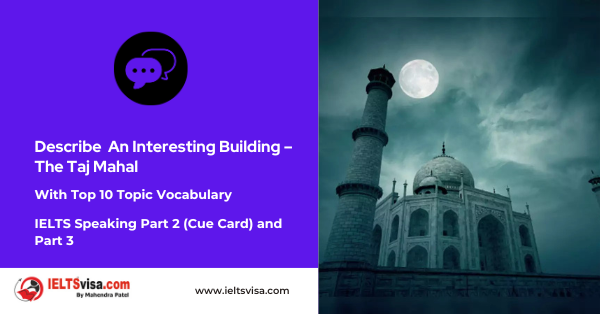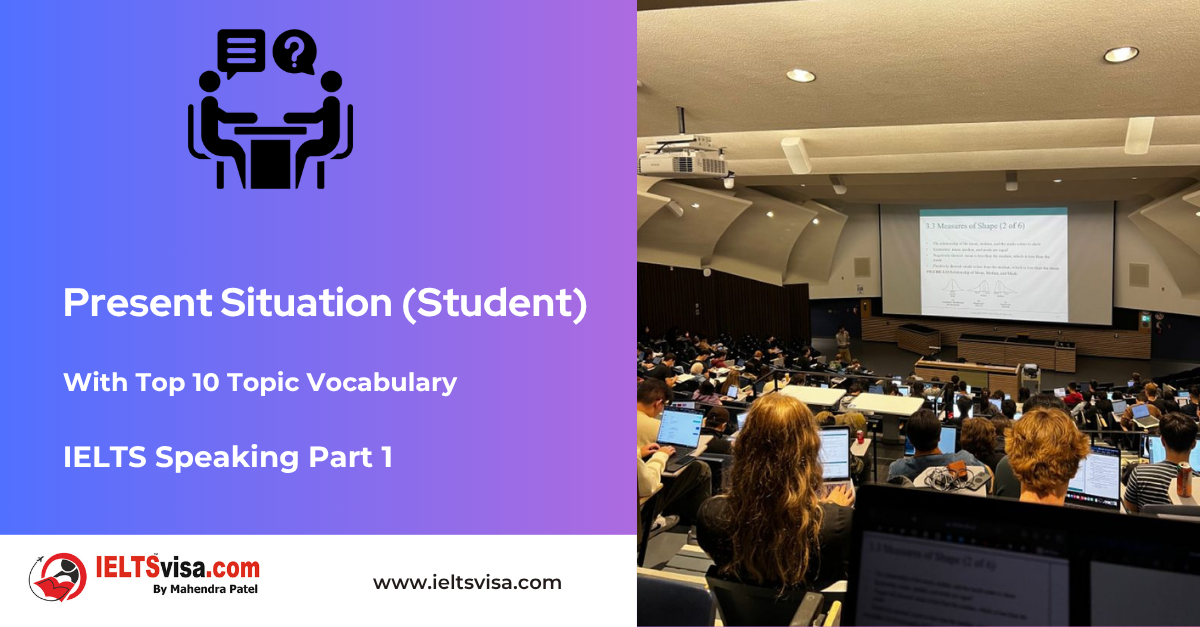Describe an interesting building.
IELTS Speaking Part 2 (Cue Card) Part 3: Follow-Up Questions
Describe an interesting building.
🗂️ Part 2 – Cue Card
Describe an interesting building.
You should say:
- Where it is located
- What it looks like
- What services are provided
- How you like it
🗣️ Sample Answer
One of the most fascinating buildings I’ve ever visited is the Taj Mahal, located in Agra, India. This architectural marvel is one of the most iconic monuments in the world and is also a UNESCO World Heritage Site.
The Taj Mahal is built entirely of white marble and features a large central dome surrounded by four elegant minarets. The design is perfectly symmetrical, with beautiful floral carvings, intricate inlay work, and detailed calligraphy on the walls. It is surrounded by lush Mughal gardens, water fountains, and a long reflecting pool that enhances its serene beauty.
Originally constructed as a mausoleum by Emperor Shah Jahan in memory of his wife Mumtaz Mahal, the building now serves as both a historical site and a symbol of eternal love. Visitors from around the globe come to witness its grandeur, and the complex offers guided tours, resting areas, and cultural exhibitions that explain its rich history.
I absolutely love the Taj Mahal for its breathtaking beauty and emotional significance. Every detail reflects artistic mastery and profound devotion, and standing before it evokes a sense of peace and admiration. It’s not just a monument, but a timeless representation of love, architecture, and culture.
🔁 Part 3: Follow-Up Questions
1. What role do old buildings and new buildings play in modern society?
Old buildings preserve history and cultural identity, while new buildings reflect innovation and current needs. Together, they create a balanced urban environment. Old structures remind us of our roots, while modern ones show how far we’ve progressed.
2. What changes have taken place in architecture in the past two decades?
Architecture has become more eco-conscious, with a focus on sustainability and energy efficiency. Designs are now more minimalistic, functional, and technologically advanced. Digital tools, such as 3D modelling and AI, have also transformed the way buildings are planned and constructed.
3. Do you think it is necessary to protect old buildings?
Yes, old buildings are important because they represent a country’s heritage and identity. Preserving them helps future generations learn about the past. They also attract tourism and add character to cities.
4. How do architectural styles reflect cultural identity?
Architecture reflects the values, beliefs, and history of a culture. For example, temples in India or mosques in the Middle East showcase religious and regional influences. By studying architecture, we gain insights into a society’s traditions and way of life.
5. What are the environmental impacts of modern architecture?
Modern architecture can either help or harm the environment. Green buildings reduce energy use and emissions, while poorly designed ones can increase pollution and resource consumption. Sustainable materials and planning are key to minimising negative impacts.
6. How does urbanisation affect architectural development?
Urbanisation prompts architects to design more space-efficient and multifunctional buildings. Cities are becoming increasingly vertical, featuring high-rise apartments and advanced smart infrastructure. However, rapid development can also lead to overcrowding and strain on resources if not managed well.
7. What role does technology play in modern architecture?
Technology allows architects to create more complex and accurate designs using software and simulations. It also helps during construction with prefabrication and automated systems. In smart buildings, technology enhances comfort, security, and energy efficiency.
8. How does architecture influence the quality of life in urban areas?
Good architecture enhances safety, convenience, and aesthetics, thereby improving daily living. Features such as green spaces, natural lighting, and proper ventilation contribute to both physical and mental well-being. Poorly designed spaces, on the other hand, can lead to stress and discomfort.
9. Why do tourists often visit historical buildings during their travels?
Tourists are drawn to historical buildings because they offer a glimpse into a country’s past and cultural identity. These structures often have unique stories, architecture, and significance that make the experience memorable. Visiting such places adds depth and context to their travel journey.
10. How can schools use architecture to enhance students’ learning experiences?
Schools can incorporate elements of architecture into subjects such as history, art, and environmental science. Field trips to significant buildings or notable design projects can foster creativity and an appreciation for space and aesthetics. Interactive learning environments also help students understand the connection between physical spaces and human behaviour.
Top 10 Topic Vocabulary – Describe an interesting building.
|
Vocabulary |
Type |
Meaning |
Synonyms |
Antonyms |
Word Family |
Example Sentence |
|
Exquisite |
Adjective |
Extremely beautiful and delicate |
Elegant, Refined |
Coarse, Unrefined |
Exquisiteness (Noun) |
The Taj Mahal’s exquisite details reflect the superb craftsmanship of its creators. |
|
Facade |
Noun |
The front of a building, especially decorated |
Front, Exterior |
Rear, Back |
– |
The marble facade of the building gleams under the sunlight. |
|
Intricate |
Adjective |
Very detailed and complex |
Elaborate, Detailed |
Simple, Plain |
Intricacy (Noun) |
The intricate designs on the walls are mesmerising. |
|
Symmetrical |
Adjective |
Balanced and identical on both sides |
Proportional, Even |
Asymmetrical, Uneven |
Symmetry (Noun) |
The structure is known for its symmetrical layout. |
|
Mausoleum |
Noun |
A large, grand tomb |
Tomb, Crypt |
– |
– |
The Taj Mahal was built as a mausoleum for Mumtaz Mahal. |
|
Splendor |
Noun |
Magnificent appearance or grandeur |
Brilliance, Glory |
Dullness, Mediocrity |
Splendid (Adjective) |
The splendour of the gardens adds to the monument’s charm. |
|
Tranquility |
Noun |
Peaceful and calm condition |
Serenity, Calmness |
Turmoil, Agitation |
Tranquil (Adjective) |
The area around the Taj Mahal is filled with tranquillity. |
|
Preservation |
Noun |
The act of maintaining or saving from harm or decay |
Conservation, Care |
Neglect, Damage |
Preserve (Verb) |
Preservation of historical sites is a shared responsibility. |
|
Sustainable |
Adjective |
Not causing damage to the environment and lasting long-term |
Eco-friendly, Green |
Wasteful, Harmful |
Sustainability (Noun) |
Modern architects aim to design sustainable buildings. |
|
Revolutionise |
Verb |
To bring about major and radical change |
Transform, Redefine |
Maintain, Preserve |
Revolution (Noun) |
3D printing has revolutionised architectural design. |

Our Books
Master IELTS Speaking Part 1
IELTS Writing Task 1 Book
IELTS Writing Task 2 Book
Practice IELTS Other Modules
IELTS Listening
The IELTS Listening test assesses how well you can understand spoken English in various contexts. It lasts about 30 minutes and is divided into four sections with a total of 40 questions. The listening tasks become increasingly difficult as the test progresses.
IELTS Academic Reading
The IELTS Academic Reading section assesses your ability to understand and interpret a variety of texts in academic settings. It is designed to evaluate a range of reading skills, including skimming for gist, reading for main ideas, reading for detail, understanding inferences, and recognizing a writer's opinions and arguments.
IELTS Speaking
The IELTS Speaking test assesses your ability to communicate in English on everyday topics. It lasts 11-14 minutes and consists of three parts: introduction, cue card, and a discussion based on the cue card topic.
IELTS General Reading
IELTS General Reading tests your ability to understand and interpret various types of texts. Here are some key areas and types of content you can expect to encounter in the reading section, along with tips for effective preparation.
IELTS Academic Writing Task 1
In IELTS Academic Writing Task 1, you are presented with a visual representation of information, such as graphs, charts, tables, or diagrams, and you are required to summarize, compare, or explain the data in your own words.
IELTS General Writing Task 1
In IELTS General Writing Task 1, you are required to write a letter based on a given situation. The letter can be formal, semi-formal, or informal, depending on the prompt. Here’s a breakdown of the key components to include in your letter
IELTS Academic Writing Task 2
In IELTS Academic Writing Task 2, you are required to write an essay in response to a question or topic. Here’s a guide to help you understand the essential elements of this task
IELTS Exam Tips
To succeed in the IELTS exam, practice regularly, familiarize yourself with the test format, improve your vocabulary, develop time management skills, and take mock tests to build confidence.
Grammer for IELTS
Grammar is the foundation of effective communication in English. Understanding tense usage, subject-verb agreement, and sentence structure enhances clarity and coherence in writing and speaking.
Vocabulary for IELTS
Vocabulary plays a crucial role in the IELTS (International English Language Testing System) exam, especially in the Speaking and Writing sections. Here’s an overview of why vocabulary is important and how it impacts your performance
RECENT IELTS SAMPLES QUESTIONS AND ANSWERS
IELTS Speaking Part 1 – Favourite Sujbect – Physics
IELTS Speaking Part 1 - Favourite Sujbect - Physics Q: What is your favourite subject? A: My favourite subject...
IELTS Speaking Part 1 – Present Situation (Student)
IELTS Speaking Part 1 - Present Situation (Student) Q1: Are you a student or do you work?A: I’m a full-time...
IELTS Speaking Part 1 – Present Situation – Employee – as an International Student and Social Worker
IELTS Speaking Part 1 - Present Situation - Employee - as an International Student and Social Worker Q1: Are...
IELTS Speaking Part 1 – Persent Situation – Employee- as an Electric Engineer
IELTS Speaking Part 1 - Persent Situation - Employee- as an Electric Engineer Q1: What do you do for a...
IELTS Speaking Part 1 – Persent Situation – Employee – as an Software Engineer
IELTS Speaking Part 1 - Persent Situation - Employee - as an Software Engineer Q1: What do you do for a...
IELTS Speaking Part 1 – Persent Situation – Married
IELTS Speaking Part 1 - Persent Situation - Married Q1: Are you married?A: Yes, I am married. My spouse and I...













